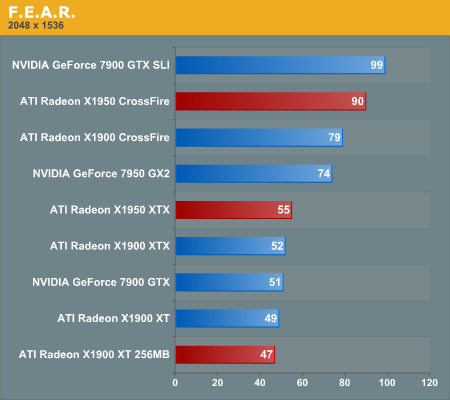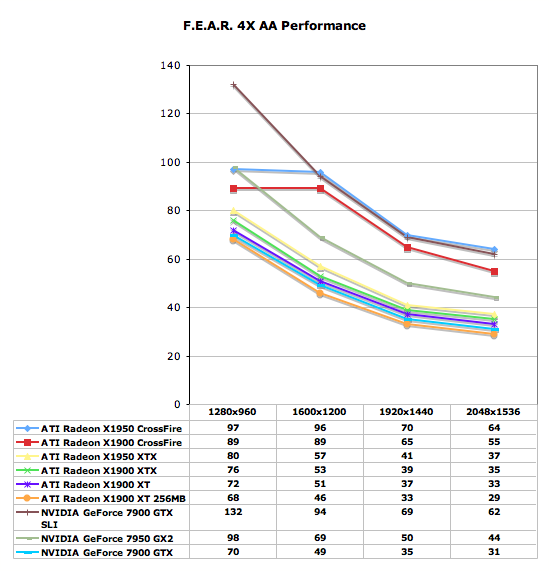ATI's New High End and Mid Range: Radeon X1950 XTX & X1900 XT 256MB
by Derek Wilson on August 23, 2006 9:52 AM EST- Posted in
- GPUs
F.E.A.R. Performance
F.E.A.R. has a built in test that we make use of in this performance analysis. This test flies through some action as people shoot each other and things blow up. F.E.A.R. is very heavy on the graphics, and we enable most of the high end settings for our test.
During our testing of F.E.A.R., we noted that the "soft shadows" don't really look soft. They jumped out at us as multiple layers of transparent shadows layered on top of each other and jittered to appear soft. Unfortunately, this costs a lot in performance and not nearly enough shadows are used to make this look realistic. Thus, we disable soft shadows in our test even though its one of the large performance drains on the system.
Again we tested with antialiasing on and off and anisotropic filtering at 8x. All options were on their highest quality with the exception of soft shadows which was disabled. Frame rates for F.E.A.R. can get pretty low for a first person shooter, but the game does a good job of staying playable down to about 25 fps.

F.E.A.R. returns to NVIDIA's 7900 GTX SLI ruling the top of the charts by 10% over the X1950 CrossFire. What's more noteworthy however is the close to 14% performance boost the X1950 CrossFire gets over the X1900 CrossFire setup, due to its 4% CrossFire card core clock speed boost and faster GDDR4 memory. Once again we see that the 7950 GX2 provides a good middle ground between the price/performance of the fastest single cards and the slowest multi-card multi-GPU setups.
Single card performance, with the exception of the GX2, is pretty close between the top contenders. The X1950 XTX is fastest but its predecessor and the 7900 GTX are not far behind. Even the X1900 XT 256MB puts out a respectable frame rate here, but it's starting to show its limits.

Without AA, nearly every configuration scales exactly the same from low resolution to high. The X1900 CrossFire score at 1280x960 is a little strange, but we confirmed the test a couple different times to make sure nothing was off. It is possible that this scaling issue is due to the lower memory clock, but we really aren't sure why we see the performance we do here. Luckily, there's no need to play at such a low resolution with a $1000 set of graphics cards.

With AA enabled, ATI gains a small advantage over NVIDIA at the very high end with its X1950 CrossFire. The standings mostly remain the same through the rest of the charts, although the 7900 GTX and 512MB X1900 XT swap places in the single card comparisons.
With single cards able to offer playable performance at 2048 x 1536 with 4X AA, we can't wait to see what the next generation of GPUs will bring us in terms of single card performance. Or, alternatively, what game developers are going to be able to do with this much power at their disposal.

The AA graph looks even stranger than the non-AA graph. Both multi card ATI solutions hit a very strange limitation at 1280x960. This isn't a traditional, easy to explain, CPU limitation. A faster memory clock on the X1950 XTX gives it an advantage at 1280x960, and the 7900 GTX SLI has no problem reaching up over 130 fps. Again, we ran this test multiple times and decided to chalk it up to mysterious and unknown driver issues. Other than these anomalies, everything else scales similarly and nothing really trades places at any point in this test.










74 Comments
View All Comments
TigerFlash - Wednesday, August 23, 2006 - link
I suppose I worded that the opposite way. Do you think Intel will stop supporting Crossfire cards?michal1980 - Wednesday, August 23, 2006 - link
Can we not even get any numbers for cards below the 7900GTX.I understand your limited, but how about some numbers from some cards below that, to see what an upgrade would do.
I know we can kind of take test from old reviews of the cards, but your test bed has changed since core 2, so its not a fair heads to heads test of old numbers to new.
it would be nice to see if theres a point(wise or not) to upgrade from a 7800gt or that gen of cards, or something slower like a 7900gt.
but it seems like ever 'new gen' card test just drops off 'older' cards
michal1980 - Wednesday, August 23, 2006 - link
what i meant is that on the tables, or where all the new cards are, it would be nice to have some numbers for old cards.Lifted - Wednesday, August 23, 2006 - link
Agreed. I'm still running a 6800GT and have not seen much of a reason to upgrade with the current software I run. Perhaps if I saw that newer games are 3x faster I might consider an upgrade, so how about it?